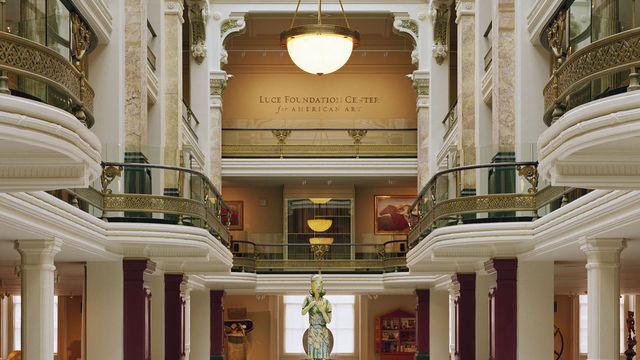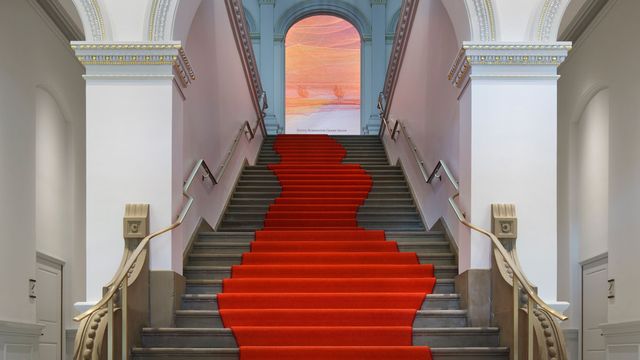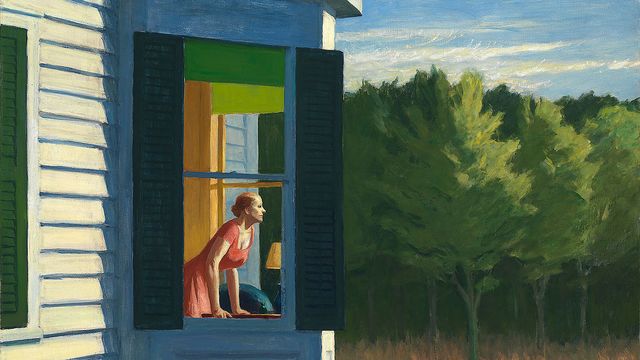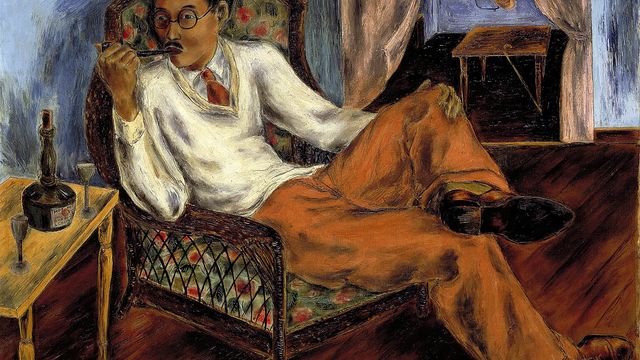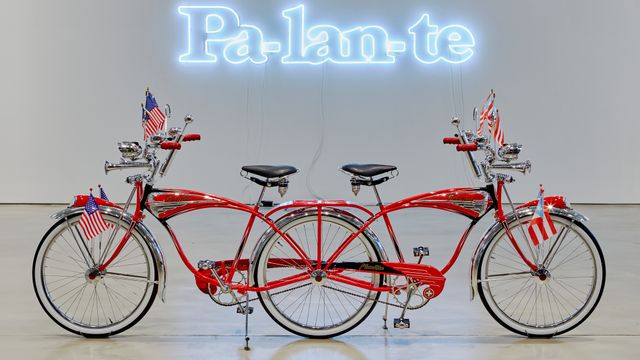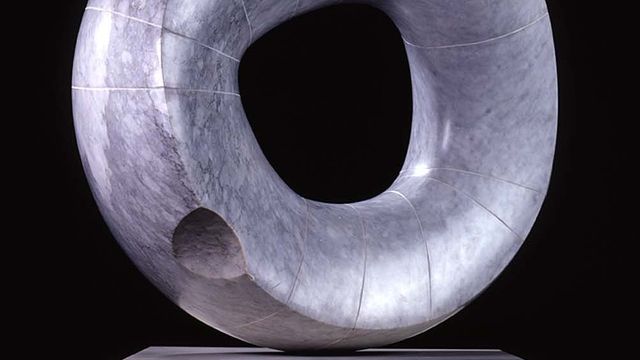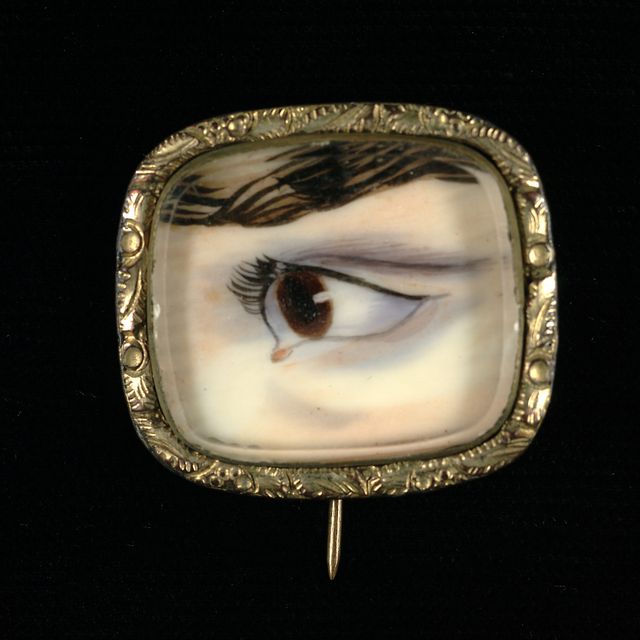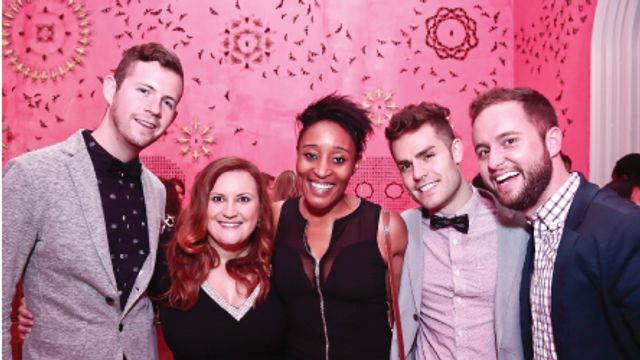Smithsonian American Art Museum — Student’s Orientation Video
Video Player is loading.
ELLIE: And I’m Ellie. We’re at the Smithsonian American Art Museum in Washington, DC, located just a few blocks from the National Mall.
S: The museum has over 41,000 artworks in its collection. Many of them are on display in this landmark building. It is also home to another museum, the National Portrait Gallery.
E: Today we’re visiting the Smithsonian American Art Museum – SAAM! Let’s go inside.
OFFICER: Sir, there’s no backpacks allowed in the museum. What I need you to do is put this in the lockers to your left. Thank you, sir.
S: Thank you.
E: Thank you.
Large bags and backpacks are not allowed inside the museum. Best to leave them behind.
S: The museum’s collection spans more than three centuries of American history. It traces the growth of our nation, both happy and sad, our heroes, and our common people.
E: The building itself has a lot of history. First, it was the patent office building. Then, during the Civil War, it became a hospital. President Lincoln had his second inaugural ball here, one month before he was shot in April 1865. In the 1950s, it was almost torn down..
S: ..to build a parking lot. Today, it’s one of our best surviving examples of Greek revival architecture.
E: You could spend a whole day here just looking at the building.
S: But we’re here to see the art, right?
E: Right. Let’s start with the birth of our country: 1776.
S: Charles Willson Peale?
E: He fought in the Revolutionary War, and was one of the most famous portrait artists of the early republic.
S: I can just barely make out what the boy’s pointing at. Let’s see: “To be or not to be.”
E: That’s why you really have to look at the paintings – so you won’t miss stuff. Some people say that those words summed up the precarious state of our new nation at that time.
S: You mean like, should we stay a part of Great Britain or take off on our own?
E: Probably something like that.
DOCENT: I have three rules for looking at art. The first rule is do not touch the artwork. The second rule is please don’t touch the artwork. And the third rule would be-
CHILD: -don’t turn around and bump into the art.
D: Excellent. So, let’s go out and take a look at the art.
S: That’s good advice. All the museum’s artwork is off-limits.
E: No matter how tempting. Always use your eyes, never your hands.
S: As the west was being settled, there was a hot marker for dramatic landscapes of the nation’s frontiers. Like this one, by Albert Bierstadt.
E: People bought tickets and stood in line to see them.
S: Right, but where are all the people? I mean, the Native Americans?
E: American Indians are one of the great subjects of American art. SAAM has a huge collection of George Catlin’s famous portraits of Native Americans.
What do you think this painting is supposed to mean?
S: I’m not sure. It looks like a man wrestling a bull.
E: Yeah, the man is Hercules, and the bull is Achelous, the Greek god who ruled the rivers. The label says that Hercules defeated the bull by tearing off one of its horns, and that became the horn of plenty.
S: Wow. It really helps knowing the story behind the painting.
Woah, what? Amazing! If you look closely, it’s lightbulbs and chairs.
E: James Hampton made his living as a night janitor. For fourteen years, he spent his spare time privately building this. It was discovered after his death, and this is only part of a much larger work.
S: That’s incredible.
E: Not everything in SAAM’s collection can be seen on display in the galleries.
S: Many artworks are fragile, and have to be kept out of bright light.
E: Cool! People in love would commission miniature portraits of their secret lover’s eyes.
S: Secret lovers? Really?
The Luce Foundation Center for American Art is a special section of SAAM. It allows us to see 3,000 more objects. Without the Luce Center, most of these objects would be in storage.
E: Wow! I wish this were my own personal jewelry box.
S: Well, it is, in a way.
E: Yeah, everything in SAAM’s collection belongs to all the American people. I got it.
S: And if you want to know more, complete information about each object and its creator is available at the computer kiosks.
E: Sonny, come on, let’s go watch one of those conservators at work.
CONSERVATOR: This is the Lunder Conservation Center. Conservation is where the works of art in the museum are cared for. It’s meticulous and careful work. Sometimes, objects end up in conservation for unfortunate reasons. Your hands have oils and salts, and when you touch a work of art, this may not show up right away, but over time it will, and so it has to come in and be worked on. Those oils have to be removed. So, don’t touch the art. Please.
S: Woah, for a second there I thought she was real!
E: Yeah, I bet you were about to say, “No eating in the museum!”
S: That’s right! But, you can eat in the courtyards, and there are benches you can sit on if you bring a lunch. Come on.
E: This looks like driftwood, but it’s not.
S: It’s not?
E: No, it’s made out of bronze.
S: Dude, you’ve got to be kidding!
E: What’s this?
S: The “Electronic Super Highway”.
E: What state are you from?
S: Arizona.
E: It’s here. People come to the museum from lots of different states. They can see what the artist picked to represent their state.
S: The Smithsonian American Art Museum includes art from all regions, cultures, and traditions within our country.
E: Art by men and women, both famous and unknown, and all media.
S: Art that is big and art that is small. Art treasures that belong to all of us.
E: Art that helps to define us and teach us what it means to be an American.
S: A place where your curiosity is the only cost of admission.
E: We hope you’ll have a great visit to the Smithsonian American Art Museum.
More Videos
Our America Audio Podcast - Elizabeth Broun, "Mis Hermanos" by Jesse Trevino
This audio podcast series discusses artworks and themes in the exhibition Our America: The Latino Presence in American Art at the Smithsonian American Art Museum.
Our America Audio Podcast - Elizabeth Broun, works by Margarita Cabrera
This audio podcast series discusses artworks and themes in the exhibition Our America: The Latino Presence in American Art at the Smithsonian American Art Museum.
Our America Audio Podcast - works by Freddy Rodriguez
This audio podcast series discusses artworks and themes in the exhibition Our America: The Latino Presence in American Art at the Smithsonian American Art Museum.
Our America Audio Podcast - Amado M. Pena Jr., "Mestizo"
This audio podcast series discusses artworks and themes in the exhibition Our America: The Latino Presence in American Art at the Smithsonian American Art Museum. In this episode, artist Amado M.

